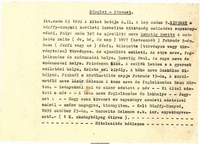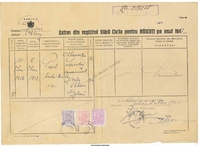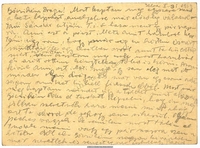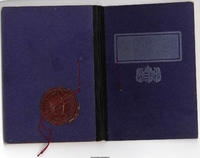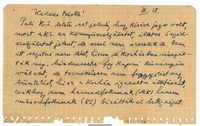The Lusztig Collection
Titlu
The Lusztig Collection
Descriere
In the 1870s, the Lusztig family left Sălaj County, settling in a number of villages around Cluj. As such, in the early 1900s, a significant part of the family, founded by Moritz Lusztig and Gizella Blum, decided to settle in Gilău, where they remained until the beginning of the Second World War. Moritz and Gizella were involved in the sale and production of rakia and had 5 children: Ákos, Sándor, Andor, Victoria and Pál, but Sándor died within the first year of his life.
During the interwar period, the Lusztig family thrived despite the anti-Semitic attitude of the non-Jews in their community. Ákos, Andor, Victoria and Pál studied at schools in Cluj, in Hungarian, which offered them the opportunity to pursue their professional goals abroad. However, the situation of the family took an unexpected turn around the Second World War, in late 1938, when Pál was summoned to provide forced labour for the benefit of the Romanian Army, which he did for two years. Immediately after the Second Vienna Award of 30 August 1940, when Transylvania was annexed to Hungary, both Pál and Andor were enrolled in the Hungarian Army for forced labour. During the same period, Ákos left Transylvania and settled in Timișoara, where he founded a family, and Gizella, the mother of the Lusztig brothers, died in 1942. Initially, Pál and Andor were assigned to the Baia Mare labour camp, and from there Pál was transferred to the Szentkiralyszabadja camp in Hungary in 1943. Andor stayed in Baia Mare until September 1944, when he died during an aerial bombing.
Meanwhile, Pál Lusztig’s fiancée, Erzsebet Mann, who was not targeted by the anti-Jewish legislation issued by the Hungarian Government, was left free and able to facilitate correspondence between the members of the Lusztig family and their close friends. In 1944, when the deportations of Jews from Transylvania started, Victoria Lusztig, who was married to Dezső Irányi, and their two children, Robert and Georg, were killed immediately after arriving at Auschwitz. Moritz Lusztig with his wife and children, Andor, Julia, Tibor and Noemi, managed to join the list of passengers for the Kasztner train, which departed from Budapest on 30 June 1944 and arrived in Switzerland in December 1944. This meant that Moritz and his family were among the 1600 Jews from Transylvania whose lives were spared by this special transport.
After the end of the Second World War, Julia and her two children continued their journey to Mandatory Palestine, and Moritz returned to Cluj. Dezső Irányi, being the only one in his family to have survived Auschwitz, returned to Cluj and founded a new family. During the chaos of the capitulation of the Hungarian Army, Pál managed to escape from the Szentkiralyszabadja camp and return to Cluj. As a result, of the six members of the Lusztig family, the only ones left alive after the end of the Second World War were Moritz, Pál and Ákos.
During the interwar period, the Lusztig family thrived despite the anti-Semitic attitude of the non-Jews in their community. Ákos, Andor, Victoria and Pál studied at schools in Cluj, in Hungarian, which offered them the opportunity to pursue their professional goals abroad. However, the situation of the family took an unexpected turn around the Second World War, in late 1938, when Pál was summoned to provide forced labour for the benefit of the Romanian Army, which he did for two years. Immediately after the Second Vienna Award of 30 August 1940, when Transylvania was annexed to Hungary, both Pál and Andor were enrolled in the Hungarian Army for forced labour. During the same period, Ákos left Transylvania and settled in Timișoara, where he founded a family, and Gizella, the mother of the Lusztig brothers, died in 1942. Initially, Pál and Andor were assigned to the Baia Mare labour camp, and from there Pál was transferred to the Szentkiralyszabadja camp in Hungary in 1943. Andor stayed in Baia Mare until September 1944, when he died during an aerial bombing.
Meanwhile, Pál Lusztig’s fiancée, Erzsebet Mann, who was not targeted by the anti-Jewish legislation issued by the Hungarian Government, was left free and able to facilitate correspondence between the members of the Lusztig family and their close friends. In 1944, when the deportations of Jews from Transylvania started, Victoria Lusztig, who was married to Dezső Irányi, and their two children, Robert and Georg, were killed immediately after arriving at Auschwitz. Moritz Lusztig with his wife and children, Andor, Julia, Tibor and Noemi, managed to join the list of passengers for the Kasztner train, which departed from Budapest on 30 June 1944 and arrived in Switzerland in December 1944. This meant that Moritz and his family were among the 1600 Jews from Transylvania whose lives were spared by this special transport.
After the end of the Second World War, Julia and her two children continued their journey to Mandatory Palestine, and Moritz returned to Cluj. Dezső Irányi, being the only one in his family to have survived Auschwitz, returned to Cluj and founded a new family. During the chaos of the capitulation of the Hungarian Army, Pál managed to escape from the Szentkiralyszabadja camp and return to Cluj. As a result, of the six members of the Lusztig family, the only ones left alive after the end of the Second World War were Moritz, Pál and Ákos.
Sursă
Donated by Flavia Hațiegan-Craioveanu
Editor
The Dr. Moshe Carmilly Institute for Hebrew and Jewish History
Ierarhie colecţie
- The Lusztig Collection


